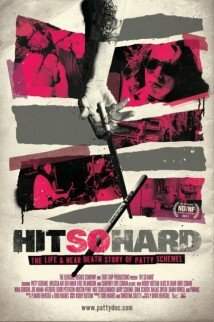We’re just barely into the Memorial Day Weekend, and I’ve already drunk so deeply from the SIFF well that I can’t do the films justice in mini-reviews. Especially the really amazing stuff. Let’s get the just-OK things out of the way first.
I took in the final SIFF screening of Everything Will Be Fine, Danish director Christoffer Boe’s thriller, on Friday. The movie follows Jacob Falk (Jens Albinus), a screenwriter wracked with writers’ block who literally collides with fate (and script inspiration) when he runs down a Danish soldier on a dark deserted road. Among the soldier’s effects; a bag full of photos graphically implicating Denmark’s peacekeeping forces in Middle East war atrocities. The movie admirably refuses to tie its story with a neat expositional bow at the end, and Boe knows how to generate slow-burn suspense, but somehow the film fails to knock it out of the park. Maybe it’s the self-absorbed and not-very-likeable protagonist, or the ending that’s just a little too Euro-ambiguous for its own good.
Jucy, meantime, harbors a lot less pretense. It’s a feather-light Aussie comedy about two true-blue buddies, Jackie and Lucy (Cindy Nelson and Francesca Gasteen), who both audition for the same play, a small-stage adaptation of Jane Eyre. Changes within the play’s casting–and within the two women–put pressure on their friendship, and much female bonding, joking, and soul-searching ensues. Despite its Down Under flavor, it’s painfully formulaic stuff. But Nelson and Gasteen are utterly enchanting; their easy chemistry together provides Jucy‘s trump card whenever director Louise Allston’s occasionally heavy hand and Stephen Vagg’s wobbly script draw deuces. Jucy screens one more time at the Kirkland Performance Center on Sunday, June 12 (8:30 p.m.).
You couldn’t ask for a sharper contrast to Jucy than The Whistleblower, a harsh fact-based thriller about human trafficking in freshly-war-wounded former Yugoslavia circa 1999. Director Larysa Kondracki pulls a lot of good out of her first feature: a first-rate, utterly believable performance by Rachel Weisz as the UN peacekeeper and titular whistle-blower; sharp supporting turns from Vanessa Redgrave and David Strathairn; and a muddily-desperate visual evocation of Bosnia that pervades the movie like an ominous fog. On the downside, Kondracki and company bite off way more than they can chew in a little over two hours; the Cliffs’ Notes condensing of an impossibly complex subject and story pulls The Whistleblower away from the realm of All the President’s Men and drops it squarely into Law and Order: SVU territory. You can judge for yourself at either of the two remaining screenings–today at 1 p.m. at the Egyptian, or Tuesday at the Everett Performing Arts Center (6:30 p.m.).
A Thousand Fools views the world through the surreal filter of Spanish director Ventura Pons, presenting over a dozen disparate vignettes ranging from comedies of manners to meditations on life’s tenuous nature to bizarre and sometimes frankly-erotic riffs on period fairy tales and legends. Movies this scattershot in structure run hot-and-cold, and ironically enough, the most successful portions prove to be the ones with their feet planted in reality. Pons brilliantly extracts a core of truth, desire, and hope from the sometimes-absurdist situations faced by his gallery of modern-day characters. The willfully-ramshackle revisionist takes on Sleeping Beauty and Robin Hood, meantime, sorta pale in comparison (A Thousand Fools has completed its SIFF run).
All of the above offered pockets of satisfaction, but the good stuff I saw in the last two days was really, really good.
Hit So Hard, the tell-all documentary about Hole drummer Patty Schemel, hits all the expected rock-doc points–youthful struggle, meteoric success, too-recently-departed collaborators, drug addiction, and redemption–capably. It’s not quite a masterpiece of the form, but Schemel–down-to-earth, feisty, and self-deprecatingly funny–makes it worth the trip. The Neptune hosts the movie’s final screening at 4 p.m. today.
Good as Hit So Hard is, though, I’ll be really surprised if a better documentary than Page One: Inside the New York Times surfaces during SIFF 2011. Director Andrew Rossi and his co-writer Kate Novack do a bang-up job of honing in on the iconic paper’s attempts to stay financially afloat and socially relevant amidst a tornado of electronic media and a landscape full of the carcasses of dead periodicals (our own Seattle P-I among them). Rossi and Novack received unprecedented access to the Times‘ inner sanctum for a year, and if their chronicle leans in the paper’s favor a bit heavily at times, you can’t blame them when you hear Times reporter David Carr eloquently defend the venerable paper from a roomful of overconfident bloggers with a few witheringly honest sentences. Talk about the teacher handing the students’ butts to ’em on a plate… (screening one more time, Monday at the Everett Performing Arts Center at 3:30 p.m.).
It’s impossible for me not to love a movie that opens with the disembodied head of a cyborg woman and a DNA-sucking Mick-Jagger-lipped samurai robot ripping the Tokyo police a new one. Amazingly, Karate-Robo Zaborgar, Robo-Geisha director Noboru Iguchi’s latest, maintains that level of delirium for 100 minutes. The movie’s an over-the-top riff on the Japanese live-action TV shows that followed in the wake of Ultraman and Kamen Rider in the 1970s, but don’t let that obscure touchstone scare you. Like Mel Brooks’ Young Frankenstein or Airplane, the rapid-fire gags and sheer imagination transcend the references, and the packed midnight house at the Egyptian (most of whom were zygotes when the original shows took foothold) loved every minute. You’ve got two more chances to see it: Monday, May 30 at 8:30 p.m. at the Admiral, and at 9:30 p.m. Wednesday June 1 at the Neptune.
My two favorite Fest flicks so far, though, re-invigorated shopworn genres even better. Viva Riva! is an absolute stunner of a caper film from The Congo, in which small-time hustler Riva (Patsha Bay) attempts to cash in on a stolen shipment of gasoline. He stumbles into a tempestuous romance with gangster moll Nora (Manie Malone), and an assemblage of gangsters, friends, and local military throw multiple wrenches into Riva’s best-laid plans. It’s a ravishingly entertaining star vehicle for the lazily-charismatic Bay, who generates classic movie-star fireworks with Malone. It’s brimming with colorful and vivid peripheral characters. It’s helmed and paced with ferocious, joyful assurance. And the movie turns deeply dark (and richly metaphoric) towards the end with a master’s modulation of tone. Director Djo Tunda wa Munga is a talent to watch, and then some. Bad news: Viva Riva’s finished its SIFF run. Good news: It’s due back later this year for a full theatrical run locally. In the name of all that’s holy, do not miss it.
Last but not least, The Last Circus is two-thirds masterpiece, one-third batshit-crazy, and I kinda adored the whole beautiful mess. It starts out as a faultlessly-mounted period drama, in which a young boy sees his world–and his circus-clown father–destroyed by the relentless wheels of the Spanish Civil War. The boy, Javier, grows into a portly, gentle young man (Carlos Areces) who takes up his father’s vocation, falling in love with trapeze artist Natalia (Carolina Bang) and running afoul of her jealous and violent beau, head circus clown Sergio. Director Alex de la Iglesia crafts a dark fable worthy of Benicio del Toro with the film’s first two acts: awash with surreal and nightmarish beauty, rich gallows humor, and truly affecting characterizations. The final act undeniably goes off the rails as Javier’s and Sergio’s rivalry for Natalia’s affections grows cartoonishly violent. But it’s a ride that’s as exhilarating, chilling, and utterly unique as it is bumpy. (Final Screening: Tuesday, May 31, 9:30 p.m. at the Neptune.)






